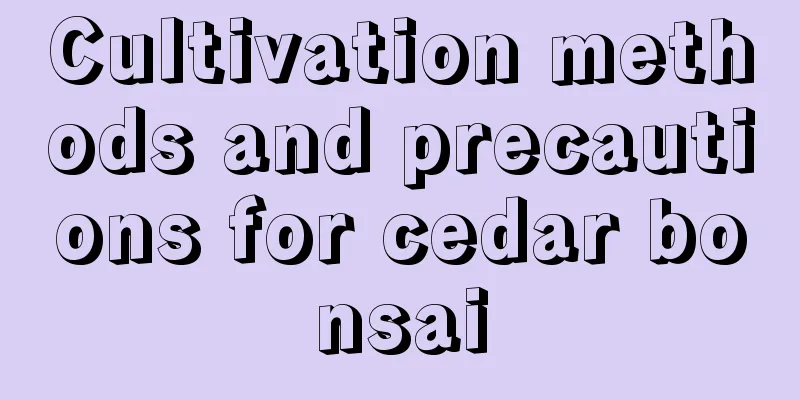Cultivation methods and precautions for cedar bonsai

1. Maintenance methods1. Soil: Thick, well-drained and air-permeable acidic soil is suitable for growing cedar bonsai. Such soil can provide it with sufficient nutrients and enable it to grow more vigorously. 2. Water: Cedar bonsai has a certain degree of drought resistance. When watering, just keep the soil moist, and avoid too much water. Cedar bonsai is afraid of water stains. If there is stagnant water, it will cause root rot. 3. Nutrients: The time for fertilization is from April to May. Use human manure and cake fertilizer and spread them evenly on the soil. Don't get too close to the roots to avoid burns. It is best to fertilize twice to three times a year. 4. Light: It likes to grow in places with sufficient light and is also a little shade-tolerant. Gentle sunlight can make its branches and leaves thick, its branches sturdy, and the tree shape more complete and beautiful. 2. Breeding techniques1. Pruning: The shape of the cedar bonsai needs to be pruned and trimmed. The branches and leaves can be cut by tying. Generally, straight trunk, double trunk, oblique trunk and jungle style are the best tree shapes. After pruning and trimming, it will be more valuable for viewing. 2. Reproduction: Generally speaking, cutting propagation has the highest survival rate and the most suitable time is spring. Cut some thicker branches, dip them in some rooting powder, insert them into soil with good air permeability, water them, provide shade and keep the soil moist. 3. Problem diagnosis and treatment1. Botrytis cinerea: Botrytis cinerea is one of the common diseases of cedar bonsai, mainly harming young shoots and twigs. If the prevention and control is not timely, it will cause great harm. Generally, it can be prevented and controlled by diluting and spraying the wettable powder of mancozeb. 2. Dry wilt disease: Mycelium is most susceptible to infection on rainy days or in relatively humid environments. This mycelium absorbs water and swells, then invades the stomata of cedar leaves, directly causing the branches and leaves to dry up. The prevention and control method is to use diluted carbendazim for spraying. IV. Other issues1. Can it be grown at home: Cedar bonsai is very suitable for growing in the home courtyard. Not only does it have a round and beautiful appearance and does not wither all year round, it can also prevent dust, so it is also very good to grow at home. 2. Can it be exposed to rain: Generally, light rain is no problem, as long as you pay attention to timely drainage. However, when encountering heavy rain or long-term rain, you should provide appropriate shelter, or tilt the pot so that no water accumulates in the pot. |
<<: Cultivation methods and precautions of Songchunhua
>>: Breeding methods and precautions of silver thorn
Recommend
How long is the growing period of lilies?
How long is the growing period of lilies? General...
What are the functions of mugwort? Are mugwort and wormwood the same?
1. Function Mugwort has a wide range of uses. Fir...
Cultivation methods and precautions of Japanese umbrella
After all, the Japanese umbel is more suitable fo...
What is the difference between cauliflower and broccoli? Are they the same thing?
1. Different types Although cauliflower and brocc...
Can I water the grapefruit tree when it is blooming?
Watering the grapefruit tree in bloom The pomelo ...
What flowers are suitable for growing in Tongling? What are the city flowers and trees?
1. Climate characteristics of Tongling Tongling C...
How to grow Flammulina velutipes
1. Processing of Flammulina velutipes Before plan...
Can mulberries be grown in pots?
Can mulberries be planted in flower pots? Mulberr...
How to prune violets?
Causes of Lean Growth Since violets need to be pr...
Care for bougainvillea during its flowering period
Differences in flowering period between north and...
How to prune large-leaf begonia (pruning time and method)
Big Leaf Begonia Pruning Time The time for prunin...
Can hawthorn be soaked in water and drunk every day? What are the taboos of soaking hawthorn in water?
1. Can I drink it in water every day? Hawthorn ca...
How to prune garlic vine after flowering and how to propagate it
1. How to prune after flowering 1. Prepare tools:...
How to grow Peruvian sugar apple
1. Soil When growing Peruvian sugar apple, it is ...
The cultivation methods and precautions of Lai grapes
1. Maintenance methods 1. Temperature: When Lai g...









